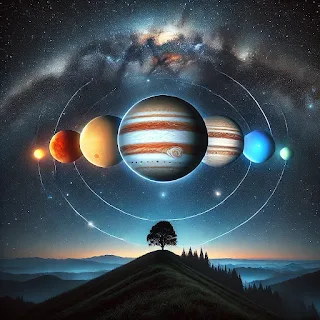In a breathtaking celestial event, an astrophotographer has successfully captured the rare 'Planetary Parade,' an alignment of multiple planets visible to the naked eye. This cosmic phenomenon, which occurs only a few times in a lifetime, mesmerized skywatchers worldwide. The stunning visuals, shared by the astrophotographer, showcase the incredible alignment of planets in a single frame, leaving astronomy enthusiasts in awe.
What is a Planetary Parade?A planetary parade occurs when
multiple planets of our solar system align in the sky, forming a seemingly
straight line from our perspective on Earth. Depending on the number of planets
involved, these alignments can be classified as small, large, or full planetary
parades. Such events are rare and often require precise conditions to be
visible without telescopic aid.
The Recent Planetary Alignment
The latest planetary parade featured
Mercury, Venus, Mars, Jupiter, and Saturn aligned in a stunning celestial
dance. This rare spectacle was visible just before dawn, offering early risers
a once-in-a-lifetime opportunity to witness the grandeur of our solar system.
Clear skies in several parts of the world allowed photographers and stargazers
to capture this unique alignment in its full glory.
Astrophotographer’s Perspective
One astrophotographer, whose images
have gone viral, managed to capture the entire alignment with a high-resolution
camera, using advanced techniques to enhance the clarity of the planets. The
images reveal the planets shining brightly against the dark sky, with each
celestial body distinguishable by its unique color and brightness. The
astrophotographer described the experience as “humbling and magical,”
emphasizing the sheer scale and beauty of the universe.
While planetary alignments are not
unheard of, alignments involving multiple bright planets are exceptionally
rare. They require precise orbits and viewing conditions, making them a treat
for astronomers and space enthusiasts alike. Such events provide a great
opportunity for scientific study, as well as public engagement with astronomy.
How to Capture Such Events?
For those interested in capturing
celestial events, astrophotographers recommend using a tripod-mounted DSLR or
mirrorless camera with long-exposure settings. A clear, dark-sky location away
from city lights is essential for the best results. Many use tracking mounts to
follow the planets’ movement across the sky, ensuring crisp and detailed
images.
Upcoming Celestial Events
If you missed this planetary parade,
don’t worry—there are several upcoming celestial events to look forward to.
Astronomers predict another significant planetary alignment in the next few
years, alongside meteor showers, eclipses, and supermoons that will provide
excellent viewing opportunities.
The recent planetary parade was a
reminder of the vastness and beauty of our universe. With the rapid advancement
of astrophotography, more people can now appreciate the wonders of the night
sky. Whether you're a professional astronomer or a casual stargazer, events
like these inspire curiosity and a deep appreciation for the cosmos. Keep your
eyes on the sky—who knows what celestial marvels await!



.jpeg)



.jpeg)



0 Comments